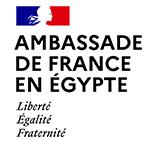Artworks focus #1
Produced in 1983 from creations dating from the 1950s by the artist Hamed Abdalla, an emblematic figure of modernism in Egypt, these four pen-and-ink slides are enlarged and suspended in the space in the form of an installation.
Representing the bodies, sometimes embracing, of women and men through Arabic calligraphy, the artist gives the concept of “expressionist letterism” or “word-form” ( الحروفية التعبيرية ), a sensitive dimension through a photographic medium evoking the intimacy of a past, forgotten moment. Fading into the representation of the silhouettes, these fragments of text play on the transparency of the support and are apprehended from both sides, summoning the wandering of the eye in front of this composition of suspended images. A game of superimposition takes place between two slides whose figuration is declined under the letters, and two others, with a more pictorial style, recalling the characteristics of cubism.
Hamed Abdalla (1917-1985), Couple fellah (in Hiéroglyphes arabes series), enlargements of pen-and-ink films on plexiglass, 70×46 cm, 1983, Collection of the Abdalla family, 2022.























































